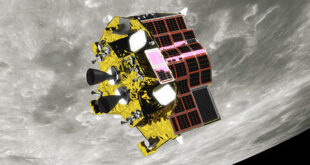
In part two of a three-part feature, Vitaly Egorov describes Russia’s modern posture in space and the challenges and possible ways of development of the national space industry. This second part looks at how space exploration is often associated with extremely ambitious goals. Which one will Russia choose for the next few decades? What will be more beneficial in terms of public support and international cooperation?
Roscosmos needs a superchallenge
In the current situation, Roscosmos’s only hope of making a quality leap forward to bridge the gap between itself and its competitors is a radical increase of funding. A large-scale programme such as a manned lunar project could attract significant funds from the government. On the other hand, re-doing the U.S. Apollo programme of fifty years ago has little propaganda value in the eyes of the nation’s leaders, which is the reason such a goal has never been set, despite Roscosmos’s multiple attempts at promoting it to the government. An alternate programme would be a national space station, but it is just as lame for propaganda purposes, in the light of the current International Space Station (ISS) programme, the future Chinese space station, and America’s plans of creating a lunar orbiting outpost. Scientific research payoff from the national station would be modest as the scientific potential of the Russian ISS segment is poorly utilized. The number of Russian scientific papers based on ISS research is smaller than those in Japan and Germany. Likewise, there is precious little cooperation with private enterprises.
Roscosmos has voiced active support for NASA’s proposal to cooperate on the lunar crewed outpost project called Deep Space Gateway. Thus, there is now a new ambitious goal for the Russian space industry, in which Russia will not face the main financial burden. A serious threat to the future lunar outpost plans remains the growing political confrontation between Russia and the U.S.. Even if cooperation in space is preserved despite the increasing confrontation, sanction wars, a conflict of foreign policy and economic interests in Central Asia and other issues, the new station project will be impossible to employ as a domestic propaganda tool. Russian political figures have been making claims of late that all ISS partners depend on the Russian crew delivery capability, thus making even ISS cooperation their propaganda tool. This won’t work in the case of the lunar outpost. The only remaining option is preserving the existing industry potential.
Being part of the lunar orbiting outpost will hardly have any development potential for Russia. The only possible exception is the manned space programme. Russia’s Federatsia spaceship currently under development has an innovative and up-to-date design, whereas the still-to-be-developed super heavy launch vehicle claims its heritage in the Soviet-era Energiya rocket. The proposed Russian modules for the joint lunar outpost will have basically the same design as those currently manufactured for the Russian ISS segment.
It is yet unknown if participation in the lunar orbiting outpost programme will increase funding for the nation’s space industry. On 2 February 2018, President Vladimir Putin signed a decree authorizing the development of the new super heavy launch vehicle for the lunar programme, but it has made no change to the Roscosmos’ budget as it is not part of the 2016-2025 Federal Space Programme. This decree, therefore, looks more like a reaction to Donald Trump’s ‘Back to the Moon’ directive, which had been signed a month before and as a pre-election move in the run-up to the March 2018 presidential election in Russia.
Currently, however, the amount of funding of the Russian space programme for the nearest decade is comparable with the funding for the previous decade. This is further aggravated by the fact that the space agency’s earnings on the international commercial launch market have been in a steady decline because of increased competition. The next few years might even see fewer crew launches to the space station. The number of Progress cargo resupply missions has recently decreased from five to three per year. In other words, there are still sufficient resources to support the existing potential, but hardly enough to invest in future development.
The President’s speech before the Federation Council on March 1, 2018, which has been dubbed Vladimir Putin’s ‘election campaign speech’, set clear priorities: military missiles were mentioned 43 times, whereas space exploitation only once, and even then in terms of the nation’s past achievements. Neither Roscosmos, nor the cosmonauts, nor the Moon or Mars got a single mention. This demonstrates the loss by the Russian space industry of its former military and propagandist importance in the eyes of the country’s leaders.
The situation is further aggravated by certain non-economic factors that the Russian space industry has had to face in the 21st Century. Corruption scandals involving top-management of the nation’s major rocket and space industry institutions have been making the headlines for the last few years. Every year a new scandal is exposed and even some distinguished figures in the industry have been put under investigation. It is against this background that making a career in the space industry is becoming less and less attractive to the younger generation. Roscosmos has little to offer to the talented and ambitious university graduates in terms of career and salary, and few find it stimulating to replicate and improve old Soviet technology for meagre pay. Even the latest cosmonaut selection campaign had to be extended by six months in order to attract the necessary number of candidates, despite the fact that the cosmonaut’s job has traditionally been highly respected in the country. Space industry institutions are trying to lure young industry specialists with wage supplements and free housing, which indeed works quite well, but is far from a radical solution. Technically gifted university graduates have much better chances of self-fulfillment in the domestic IT sphere.
This shortage of skilled human resources and their deteriorating performance have caused the growing failure rate of rockets. Launch insurance rates have increased because of the high failure rate of the Proton rocket, which made this launch vehicle even less attractive to international customers and exacerbated the issues within the Khrunichev Space Center, Proton’s manufacturer.
In part three of this three-part feature on Russia’s modern posture in space, Vitaly Egorov will look at how commercial alternatives can help fulfill Russia’s space ambitions and honour its heritage. Part III will be published on Monday, 26 March 2018.

Vitaly Egorov is a PR specialist for the Russian private company Dauria Aerospace. He has a blog under the nickname Zelenyikot, manages the group called Open Space on Facebook and vk.com with the total number of followers exceeding one million, and promotes space exploration in every possible way. He spotted the landing module of the Soviet probe Mars 3 on the Martian surface for the first time and initiated the microsatellite project for taking pictures of the Apollo and Lunokhod landing areas on the Moon.
 SpaceWatch.Global An independent perspective on space
SpaceWatch.Global An independent perspective on space




